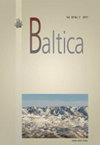The temporal and spatial variability of coastal dune erosion in the Polish Baltic coastal zone
IF 0.6
4区 地球科学
Q4 GEOLOGY
引用次数: 12
Abstract
The study looked at the temporal and spatial variability of dune erosion in the Polish Baltic coastal zone in the period 1972–2008. The dynamics of coastal dune erosion in the area are presented in relationship to the main hydro-meteorological factors: storm surges and types of atmospheric circulation. The greatest destruction of the coastal dunes in Poland was observed on sandbar sections, where the erosion was over 100,000 m3 per 1 km, causing dune baseline retreat by several tens of meters. The main causes of this considerable coastal erosion are the sudden rise of the sea level and the waves during extreme storm surges, when the loss of dune sediment across the entire Polish Baltic Sea coastal zone can reach about 400,000 m3. These extremely erosive storm surges are particularly generated by cyclonic atmospheric circulation, which accounts for more than 52% of such surges from the north-west, north, and west. It was also found that sea level increases of more than 1 meter (about 602 cm) above the mean sea level (about 500 cm) can result in significant erosion of coastal dunes in Poland (>100,000 m3). However, there is a relationship between the intensity of the dune erosion and sea level. The results of the present study could be applied to studies of Baltic coastal dunes functioning in the lagoon-spit coastline, especially in the stretch from Estonia to Germany.波兰波罗的海海岸带海岸沙丘侵蚀的时间和空间变化
这项研究考察了1972年至2008年期间波兰波罗的海沿岸地区沙丘侵蚀的时间和空间变化。介绍了该地区海岸沙丘侵蚀的动力学与主要水文气象因素:风暴潮和大气环流类型的关系。波兰海岸沙丘的破坏最大的是沙洲部分,那里的侵蚀量超过每1公里100000立方米,导致沙丘基线后退了几十米。造成这种严重海岸侵蚀的主要原因是海平面的突然上升和极端风暴潮期间的海浪,当时整个波兰波罗的海海岸带的沙丘沉积物损失可达约400000立方米。这些极具侵蚀性的风暴潮尤其是由气旋大气环流产生的,气旋大气环流占西北、北部和西部风暴潮的52%以上。研究还发现,海平面比平均海平面(约500厘米)高出1米(约602厘米)以上,会导致波兰海岸沙丘的严重侵蚀(>100000立方米)。然而,沙丘侵蚀的强度和海平面之间存在关系。本研究的结果可应用于研究泻湖吐口海岸线中的波罗的海海岸沙丘,特别是从爱沙尼亚到德国的海岸线。
本文章由计算机程序翻译,如有差异,请以英文原文为准。
求助全文
约1分钟内获得全文
求助全文
来源期刊

Baltica
地学-地质学
CiteScore
1.30
自引率
14.30%
发文量
6
审稿时长
>12 weeks
期刊介绍:
BALTICA is an international periodical journal on Earth sciences devoted to the Baltic countries region and the Baltic Sea problems. This edition as a Yearbook is established in 1961 by initiative of Academician Vytautas Gudelis. Since 1993, an Editor-in-Chief of the journal became Academician Algimantas Grigelis. BALTICA is published biannually (in June and December) in cooperation with geoscientists of the circum-Baltic States.
BALTICA is publishing original peer-reviewed papers of international interests on various Earth sciences issues. The particular emphasis is given to Quaternary geology, climate changes and development of ecosystems, palaeogeography, environmental geology, as well as stratigraphy, tectonics, sedimentology and surface processes with relevance to the geological history of the Baltic Sea and land areas. Journal emphasizes modern techniques, methodology and standards. The journal structure comprises original articles, short reviews, information, bibliography.
 求助内容:
求助内容: 应助结果提醒方式:
应助结果提醒方式:


